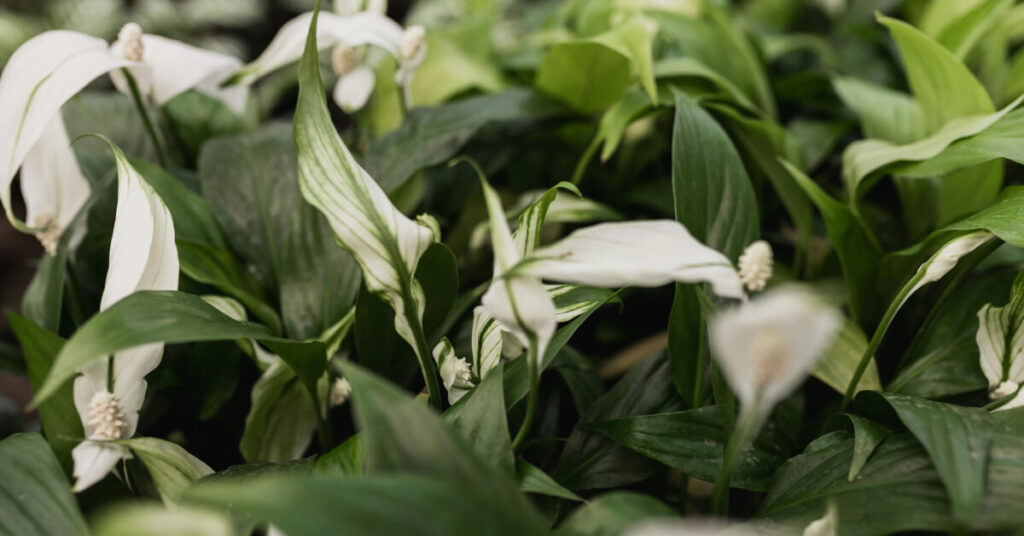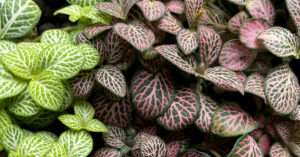Spathiphyllum
Peace lily stands as one of the most beloved flowering houseplants, combining elegant white blooms with lush green foliage and remarkable air-purifying abilities. This graceful beauty brings both visual sophistication and natural tranquility to any space while remaining surprisingly easy to care for, making it perfect for anyone seeking the joy of indoor flowers without the complexity of outdoor gardening.
Why Peace Lily Deserves a Place in Every Home
Native to the tropical rainforests of Central and South America, Spathiphyllum has become a symbol of peace, prosperity, and pure elegance in homes worldwide. Its stunning white spathe flowers—often mistaken for petals but actually modified leaves—create striking contrast against deep green foliage while lasting for weeks at a time. Beyond its beauty, NASA research has identified peace lily as one of the top air-purifying plants, effectively removing harmful toxins like ammonia, benzene, formaldehyde, and trichloroethylene from indoor air.
What makes peace lily truly special is its exceptional communication skills. The plant provides unmistakable visual cues about its needs, dramatically drooping when thirsty and perking up within hours of watering. This responsive nature, combined with its tolerance for lower light conditions and ability to bloom indoors, makes it an ideal choice for both novice plant parents and experienced gardeners seeking reliable flowering beauty.
Care Requirements
Light Requirements
Low to bright indirect light
Peace lily demonstrates remarkable adaptability to various lighting conditions, making it one of the few flowering plants that thrives in lower light situations. While it produces more abundant blooms in bright, indirect light, it maintains healthy foliage and occasional flowers even in north-facing windows or office environments with fluorescent lighting. Avoid direct sunlight, which can scorch the delicate leaves and cause the elegant white flowers to fade prematurely.
Watering
Moderate to high frequency
Peace lily prefers consistently moist soil and provides the clearest watering signals of any houseplant. Water when the top inch of soil feels dry, typically every 5-7 days during the growing season. The plant’s dramatic drooping when thirsty makes it nearly impossible to forget watering schedules. Water thoroughly until excess drains from the bottom, ensuring the entire root system receives moisture without creating waterlogged conditions.
Soil Type
Well-draining, moisture-retentive potting mix
Use a high-quality potting mix that balances moisture retention with proper drainage. Standard indoor potting soil works well, though adding a small amount of peat moss or coco coir can improve moisture retention for this water-loving plant. The soil should feel evenly moist after watering but never soggy or waterlogged, as peace lilies are susceptible to root rot in overly wet conditions.
Temperature
65-80°F (18-27°C)
Peace lily thrives in the warm, stable temperatures typical of most homes but shows sensitivity to temperature fluctuations and cold drafts. Maintain consistent temperatures between 65-80°F for optimal growth and flowering. Keep your plant away from air conditioning vents, heating sources, and exterior doors where temperature changes can stress the plant and reduce flowering.
Humidity
High to medium
Higher humidity levels promote lush growth, better flowering, and healthier foliage in peace lilies. Aim for 50-60% humidity when possible, using humidifiers, pebble trays, or grouping with other plants to create a more humid microenvironment. While the plant tolerates average household humidity, increased moisture in the air results in more vibrant foliage and more frequent blooming cycles.
Fertilizing
Regular feeding during growing season
Peace lily benefits from consistent nutrition during its active growing period to support both foliage growth and flower production. Apply a balanced liquid fertilizer monthly from spring through early fall, diluted to half strength to prevent root burn. The plant responds particularly well to fertilizers with slightly higher phosphorus content, which promotes better flowering. Reduce or eliminate feeding during winter months when growth naturally slows.
Seasonal Care Adjustments
Spring/Summer (Growing Season):
- Water every 5-7 days or when soil surface dries
- Monthly fertilizing promotes flowering and growth
- Ideal time for repotting and division
- Monitor for increased flower production
Fall/Winter (Slower Growth):
- Reduce watering frequency as growth slows
- Stop or significantly reduce fertilizing
- Lower light tolerance increases
- Flowering may decrease naturally—this is normal
Mature Size and Flowering Habits
Peace lily varieties range from compact 12-inch specimens perfect for tabletops to impressive 3-4 foot floor plants that command attention in any room. Most varieties reach their mature size within 2-3 years, producing multiple flower cycles throughout the year when conditions are optimal. The distinctive white spathes typically last 4-6 weeks before gradually turning green and fading, with new flowers emerging from the center of the plant. With proper care, peace lilies can bloom multiple times per year and live for many years, becoming increasingly impressive as they mature and develop multiple crowns.
Difficulty Level
Easy to moderate
Peace lily ranks among the most forgiving flowering houseplants, providing clear visual feedback about its needs while tolerating minor care mistakes. The combination of easy care requirements and reliable flowering makes it an excellent choice for beginners seeking success with blooming plants.
Pet and Child Safety
Important: Peace lily is toxic to pets and children if ingested. The plant contains calcium oxalate crystals that can cause mouth irritation, difficulty swallowing, drooling, and digestive upset in both animals and humans. While rarely life-threatening, consumption should be avoided. Place peace lilies out of reach of curious pets and small children, or consider pet-safe flowering alternatives if ingestion is a concern.
Varieties to Consider
While the classic peace lily remains most popular, several varieties offer different sizes and characteristics:
- Spathiphyllum ‘Sensation’: Large variety reaching 4-6 feet with massive leaves
- Spathiphyllum ‘Mauna Loa’: Medium-sized with abundant flowering
- Spathiphyllum ‘Petite’: Compact variety perfect for small spaces and tabletops
- Spathiphyllum ‘Domino’: Variegated leaves with white and green patterns
- Spathiphyllum ‘Piccolino’: Dwarf variety ideal for terrariums and small containers
Plants That Pair Well with Peace Lily
Peace lily’s elegant form and moderate care requirements make it an excellent companion for other tropical and flowering plants. Its lush foliage provides beautiful backdrop while its white flowers add sophisticated color to plant groupings.
Perfect Companions:
- Monstera Deliciosa – Similar humidity needs with complementary tropical appeal
- Pothos varieties – Comparable watering schedules with contrasting growth habits
- Chinese Evergreen – Similar light tolerance with colorful foliage contrast
- Boston Fern – Shared love of humidity and filtered light conditions
- Rubber Plant – Complementary care needs with different architectural form
Tropical Collections: Create lush, jungle-like displays by combining peace lily with other humidity-loving plants like philodendrons, alocasias, and ferns. These combinations thrive in similar conditions and create cohesive tropical environments.
Aesthetic Pairings: Peace lily serves as an excellent focal point plant, with its white flowers providing natural color coordination for any plant grouping. Its upright form works beautifully with trailing plants like pothos or ivy, creating dynamic vertical displays with varying textures and growth patterns.
Common Problems and Solutions
Overwatering
Symptoms: Yellow leaves with brown spots, mushy stems, root rot, moldy soil smell
Solution: Reduce watering frequency, improve drainage, remove affected roots and repot
Underwatering
Symptoms: Dramatic leaf drooping, brown crispy leaf tips, wilted appearance
Solution: Water thoroughly and establish more consistent watering schedule
Low Humidity
Symptoms: Brown leaf tips, reduced flowering, small new leaves, pest susceptibility
Solution: Increase humidity with humidifier, pebble trays, or plant groupings
Poor Flowering
Symptoms: Healthy foliage but no blooms, green flowers instead of white
Solution: Increase light levels, ensure proper fertilizing, check for root-bound conditions
Pest Issues
Symptoms: Spider mites, scale insects, mealybugs on leaves and stems
Solution: Regular inspection, neem oil treatment, improve air circulation and humidity
Encouraging Blooming
Getting your peace lily to flower consistently requires attention to several key factors that promote the plant’s natural blooming cycle.
Light Optimization: While peace lily tolerates low light, brighter indirect light significantly increases flowering frequency. Position near east-facing windows or supplement with grow lights during darker months.
Proper Fertilization: Regular feeding during growing season provides the energy needed for flower production. Use balanced fertilizer monthly, or try high-phosphorus fertilizer to specifically promote blooming.
Adequate Humidity: Higher humidity levels support the plant’s overall health and flowering capacity. Aim for 50% or higher humidity when possible.
Root-Bound Conditions: Slightly root-bound peace lilies often flower more readily than those in oversized pots. Repot only when absolutely necessary, moving up just one pot size.
Seasonal Cycling: Some growers find that allowing the plant to experience slightly cooler temperatures (60-65°F) for a few weeks in winter can trigger spring blooming.
Propagation
Peace lily propagation is straightforward through division, making it easy to create new plants or rejuvenate older specimens:
Division Method:
- Remove plant from pot during repotting season (spring)
- Gently separate natural divisions with roots attached
- Each division should have several leaves and healthy root system
- Plant divisions in fresh potting soil
- Water thoroughly and keep in bright, indirect light
- New growth appears within 2-4 weeks
Care for New Divisions: Keep newly divided plants slightly more moist than established plants and provide higher humidity until new growth indicates successful establishment.
Your Gateway to Flowering Plant Success
Peace lily represents the perfect introduction to the world of flowering houseplants, combining reliable blooms with forgiving care requirements and clear communication about its needs. Its air-purifying abilities, elegant aesthetic, and symbolic meaning of peace and prosperity make it a meaningful addition to any home or office environment.
Whether you’re seeking your first flowering plant or adding to an established collection, peace lily provides the satisfaction of regular blooms without the complexity of temperamental flowering species. Start with this graceful beauty, and you’ll discover the joy of having fresh flowers blooming in your home year-round, naturally and sustainably.




